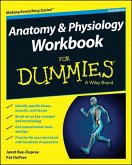

Alle Infos zum eBook verschenken

- Format: PDF
- Merkliste
- Auf die Merkliste
- Bewerten Bewerten
- Teilen
- Produkt teilen
- Produkterinnerung
- Produkterinnerung

Hier können Sie sich einloggen

Bitte loggen Sie sich zunächst in Ihr Kundenkonto ein oder registrieren Sie sich bei bücher.de, um das eBook-Abo tolino select nutzen zu können.
Learn about the human body from the inside out Some people think that knowing about what goes on inside the human body can sap life of its mystery--which is too bad for them. Anybody who's ever taken a peak under the hood knows that the human body, and all its various structures and functions, is a realm of awe-inspiring complexity and countless wonders. The dizzying dance of molecule, cell, tissue, organ, muscle, sinew, and bone that we call life can be a thing of breathtaking beauty and humbling perfection. Anatomy & Physiology For Dummies combines anatomical terminology and function so…mehr
- Geräte: PC
- mit Kopierschutz
- eBook Hilfe
- Größe: 20.89MB
![Anatomy & Physiology Workbook For Dummies with Online Practice (eBook, PDF) Anatomy & Physiology Workbook For Dummies with Online Practice (eBook, PDF)]() Erin OdyaAnatomy & Physiology Workbook For Dummies with Online Practice (eBook, PDF)15,99 €
Erin OdyaAnatomy & Physiology Workbook For Dummies with Online Practice (eBook, PDF)15,99 €![Anatomy & Physiology All-in-One For Dummies (+ Chapter Quizzes Online) (eBook, PDF) Anatomy & Physiology All-in-One For Dummies (+ Chapter Quizzes Online) (eBook, PDF)]() Erin OdyaAnatomy & Physiology All-in-One For Dummies (+ Chapter Quizzes Online) (eBook, PDF)25,99 €
Erin OdyaAnatomy & Physiology All-in-One For Dummies (+ Chapter Quizzes Online) (eBook, PDF)25,99 €![Anatomy & Physiology For Dummies (eBook, ePUB) Anatomy & Physiology For Dummies (eBook, ePUB)]() Erin OdyaAnatomy & Physiology For Dummies (eBook, ePUB)17,99 €
Erin OdyaAnatomy & Physiology For Dummies (eBook, ePUB)17,99 €![Anatomy & Physiology Workbook For Dummies with Online Practice (eBook, ePUB) Anatomy & Physiology Workbook For Dummies with Online Practice (eBook, ePUB)]() Erin OdyaAnatomy & Physiology Workbook For Dummies with Online Practice (eBook, ePUB)15,99 €
Erin OdyaAnatomy & Physiology Workbook For Dummies with Online Practice (eBook, ePUB)15,99 €![Anatomy and Physiology Workbook For Dummies (eBook, PDF) Anatomy and Physiology Workbook For Dummies (eBook, PDF)]() Janet Rae-DupreeAnatomy and Physiology Workbook For Dummies (eBook, PDF)13,99 €
Janet Rae-DupreeAnatomy and Physiology Workbook For Dummies (eBook, PDF)13,99 €![Anatomy & Physiology All-in-One For Dummies (+ Chapter Quizzes Online) (eBook, ePUB) Anatomy & Physiology All-in-One For Dummies (+ Chapter Quizzes Online) (eBook, ePUB)]() Erin OdyaAnatomy & Physiology All-in-One For Dummies (+ Chapter Quizzes Online) (eBook, ePUB)25,99 €
Erin OdyaAnatomy & Physiology All-in-One For Dummies (+ Chapter Quizzes Online) (eBook, ePUB)25,99 €![The Inner Clock (eBook, PDF) The Inner Clock (eBook, PDF)]() Lynne PeeplesThe Inner Clock (eBook, PDF)11,95 €
Lynne PeeplesThe Inner Clock (eBook, PDF)11,95 €-
-
-
Dieser Download kann aus rechtlichen Gründen nur mit Rechnungsadresse in A, B, BG, CY, CZ, D, DK, EW, E, FIN, F, GR, HR, H, IRL, I, LT, L, LR, M, NL, PL, P, R, S, SLO, SK ausgeliefert werden.
- Produktdetails
- Verlag: John Wiley & Sons
- Seitenzahl: 384
- Erscheinungstermin: 8. März 2017
- Englisch
- ISBN-13: 9781119345367
- Artikelnr.: 52545994
- Verlag: John Wiley & Sons
- Seitenzahl: 384
- Erscheinungstermin: 8. März 2017
- Englisch
- ISBN-13: 9781119345367
- Artikelnr.: 52545994
- Herstellerkennzeichnung Die Herstellerinformationen sind derzeit nicht verfügbar.
About This Book 2
Foolish Assumptions 2
Icons Used in This Book 3
Beyond the Book 3
Where to Go from Here 4
Part 1: Locating Physiology on the Web of Knowledge 5
Chapter 1: Anatomy and Physiology: The Big Picture 7
Scientifically Speaking 7
How anatomy and physiology fit into science 8
Anatomy, gross and otherwise 10
A Little Chat about Jargon 11
Creating better communication 11
Establishing precise terminology 11
Looking at the Body from the Proper Perspective 13
Getting in position 13
Dividing the anatomy 15
Mapping out your regions 15
Casing your cavities 19
Organizing Yourself on Many Levels 21
Level I: The cellular level 23
Level II: The tissue level 23
Level III: The organ level 23
Level IV: The organ system level 23
Level V: The organism level 24
Chapter 2: What Your Body Does All Day 27
Transferring Energy: A Body's Place in the World 28
Building Up and Breaking Down: Metabolism 28
Why your cells metabolize 29
How your cells metabolize 30
Staying in Range: Homeostasis 33
Maintaining a constant temperature: Thermoregulation 34
Swimming in H2O: Fluid balance 35
Adjusting the fuel supply: Blood glucose concentration 35
Measuring important variables 36
Growing, Replacing, and Renewing 37
Growing 37
Replacing 37
Repairing parts 39
Healing wounds 39
Lasting parts 40
Chapter 3: A Bit about Cell Biology 43
The Functions of Cells 43
Building themselves 44
Building tissues 45
Transforming energy 45
Making and transporting products 45
Communicating 46
Seeing the Inside of Eukaryotic Cells 46
Containing the cell: Cell membrane 48
Controlling the cell: Nucleus 51
Cytoplasm 51
Internal membranes 52
Powering the cell: Mitochondria 52
The protein factory 53
Lysosomes 54
Building Blocks That Build You 54
Joining together: The structure of macromolecules 54
Polysaccharides 55
Lipids 55
Proteins 56
Nucleic acids 57
Genes and Genetic Material 58
Traiting you right 59
Gene structure 59
Synthesizing protein 60
The Cell Cycle 62
Cells that divide, cells that don't 62
Interphase 64
DNA replication 64
Mitosis 64
Organizing Cells into Tissues 67
Connecting with connective tissue 67
Continuing with epithelial tissue 68
Mixing it up with muscle tissue 70
Getting nervous about nervous tissue? 70
Part 2: Sizing Up the Structural Layers 71
Chapter 4: Getting the Skinny on Skin, Hair, and Nails 73
Functions of the Integument 74
Structure of the Integument 75
Touching the epidermis 75
Exploring the dermis 79
Getting under your skin: The hypodermis 81
Accessorizing Your Skin 81
Now hair this 81
Nailing nails 82
Nothing's bland about glands 82
Your Skin Saving You 84
Controlling your internal temperature 85
Your skin is sensational 85
Your skin is self-healing 86
Pathophysiology of the Integument 86
Skin cancer 86
Dermatitis 87
Alopecia 87
Nail problems as signs of possible medical conditions 88
Chapter 5: Scrutinizing the Skeletal System 89
Reporting for Duty: The Jobs of Your Skeleton 90
Checking Out the Skeleton's Makeup 90
Caring about connective tissue 90
The structure of a bone 93
Classifying bones 94
Bone Growth and Remodeling 95
The Axial Skeleton 96
Keeping your head up: The skull 97
Setting you straight on the curved spinal column 99
Being caged can be a good thing 101
The Appendicular Skeleton 102
Wearing girdles: Everybody has two 103
Going out on a limb: Arms and legs 105
Joints and the Movements They Allow 110
Categorizing the types of joints 110
Knowing what your joints can do 111
Pathophysiology of the Skeletal System 113
Abnormal curvature 113
Osteoporosis 113
Cleft palate 114
Arthritis 114
Fractures 115
Chapter 6: Muscles: Setting You in Motion 117
Functions of the Muscular System 118
Supporting your structure 118
Moving you 118
Poised positioning 119
Maintaining body temperature 119
Pushing things around inside 119
Talking about Tissue Types 121
Defining unique features of muscle cells 121
Skeletal muscle 123
Cardiac muscle 125
Smooth muscle 125
Getting a Grip on the Sliding Filament 126
Assembling a sarcomere 126
Telling the fiber to contract 127
Contracting and releasing the sarcomere 128
Naming the Skeletal Muscles 129
Starting at the top 130
Twisting the torso 132
Spreading your wings 135
Getting a leg up 136
Pathophysiology of the Muscular System 138
Muscular dystrophy 139
Muscle spasms 139
Fibromyalgia 140
Part 3: Talking to Yourself 141
Chapter 7: The Nervous System: Your Body's Circuit Board 143
Integrating the Input with the Output 144
Nervous tissues 144
Neurons 145
Neuroglial cells 146
Nerves 147
Ganglia and plexuses 147
Integrated Networks 147
Central nervous system 148
Peripheral nervous system 149
Thinking about Your Brain 150
Keeping conscious: Your cerebrum 152
Making your moves smooth: The cerebellum 152
Coming up roses: Your brain stem 153
Regulating systems: The diencephalon 154
Following fluid through the ventricles 154
Blood-brain barrier 155
Transmitting the Impulse 156
Across the neuron 156
Across the synapse 158
Making Sense of Your Senses 161
Touch 162
Hearing and balance 162
Sight 163
Olfaction 164
Taste 165
Pathophysiology of the Nervous System 166
Chronic pain syndrome 166
Multiple sclerosis 166
Macular degeneration 166
Chapter 8: The Endocrine System: Releasing Chemical Messages 167
Homing In on Hormones 168
Hormone chemistry 168
Hormone sources 169
Hormone receptors 171
Grouping the Glands 172
The taskmasters: The hypothalamus and pituitary 173
Controlling metabolism 175
Getting the gonads going 178
Enteric endocrine 180
Other endocrine glands 182
Pathophysiology of the Endocrine System 183
Abnormalities in insulin metabolism 183
Thyroid disorders 184
Androgen insensitivity 186
Part 4: Exploring the Inner Workings of the Body 187
Chapter 9: The Cardiovascular System: Getting Your Blood Pumping 189
Getting Substances from Here to There 190
Carrying Cargo: Your Blood and What's in It 190
Watering down your blood: Plasma 190
Transporting oxygen and carbon dioxide: Red blood cells 191
Plugging along with platelets 192
Putting up a good fight: White blood cells 192
Looking at Your Blood Vessels 193
Starting with the arteries 193
Cruising through the capillaries 194
Visiting the veins 196
Cardiac Anatomy 197
Sizing up the heart's structure 197
Examining the heart's tissues 199
Supplying blood to the heart 200
Cardiac Cycle 201
Generating electricity 201
Moving blood through the heart 204
The heartbeat 205
Physiology of Circulation 206
On the beating path: The circuits of blood through the heart and body 206
Putting your finger on your pulse 208
Going up, going down, holding steady: Blood pressure 208
Not going with the flow 209
Pathophysiology of the Cardiovascular System 210
Cardiac disorders 210
Vascular disorders 211
Blood disorders 212
Chapter 10: The Respiratory System: Breathing Life into Your Body 215
Functions of the Respiratory System 215
Nosing around Your Respiratory Anatomy 216
Nose 216
Pharynx 217
Trachea 219
Lungs 219
Diaphragm 220
Breathing: Everybody's Doing It 220
Normal breathing 221
Breathing under stress 221
Controlled breathing 222
Gas Exchange 224
The respiratory membrane 224
The trade-off 225
Pathophysiology of the Respiratory System 226
Hypoxemia 226
Airway disorders 227
Lungs 228
Chapter 11: The Digestive System: Beginning the Breakdown 231
Functions of the Digestive System 232
The Alimentary Canal 233
Examining the walls of the digestive tract 233
Starting with the mighty mouth 234
Pharynx and esophagus: Not Egyptian landmarks 235
Stirring it up in your stomach 236
Moving through the intestines 238
Accessory Organs 240
The liver delivers 241
Pancreas 243
The Breakdown 244
Pathophysiology of the Digestive System 246
Diseases of the oral cavity 246
Disorders of the stomach and intestines 246
Bowel syndromes 248
Diseases of the accessory organs 249
Chapter 12: The Urinary System: Cleaning Up the Act 253
Functions of the Urinary System 253
Structures of the Urinary System 255
Putting out the trash: Kidneys 255
Holding and releasing 257
The Yellow River 259
Composition of urine 259
Filtering the blood 261
Selectively reabsorbing 261
Expelling urine 263
Maintaining Homeostasis 264
Fluid balance and blood pressure 264
Regulating blood pH 265
Pathophysiology of the Urinary System 267
Kidney pathologies 267
Urinary tract pathologies 268
Chapter 13: The Lymphatic System: Living in a Microbe Jungle 271
Functions of the Lymphatic System 272
Loving Your Lymphatic System 273
Lymphing along 273
Structures of the lymphatic system 274
Identifying Immune System Cells 277
Looking at leukocytes 278
Lymphocytes 279
Phagocytizing leukocytes 280
Examining Immune System Molecules 280
Histamine 281
Chemical defense 281
Antigens 281
Antibodies 282
Complement system proteins 283
Immune System Mechanisms 284
Phagocytosis 284
Degranulation 285
Inflammation is swell 285
Adaptive Immunity 286
Cell-mediated immunity 286
Humoral immunity 287
Secondary immunity 289
Immunization 289
Pathophysiology of the Immune System 289
The immune system and cancer 289
Immune-mediated diseases 290
Infectious diseases 292
Part 5: Life's Rich Pageant: Reproduction and Development 295
Chapter 14: The Reproductive System 297
Functions of the Reproductive System 297
Producing Gametes 298
Meiosis 299
Female gametes: Ova 299
Male gametes: Sperm 301
Determining sex 302
The Female Reproductive System 303
Organs of the female reproductive system 303
Cycling approximately monthly 307
The Male Reproductive System 310
The organs of the male reproductive system 310
Seminal fluid and ejaculation 312
Pausing for Pregnancy 313
Steps to fertilization 313
Implantation 314
Adapting to pregnancy 314
Labor and delivery 316
Pathophysiology of the Reproductive System 318
Infertility 318
Sexually transmitted infections 318
Premenstrual syndromes 319
Endometriosis 319
Cryptorchidism 320
Hypogonadism 320
Erectile dysfunction 320
Pathophysiology of pregnancy 320
Pregnancy loss 322
Chapter 15: Change and Development over the Life Span 323
Programming Development 324
Stages of development 324
Dimensions of development 324
Development before Birth 326
Free-floating zygote to protected embryo 326
Dividing development into trimesters 329
The Human Life Span 331
Changes at birth 331
Infancy and childhood 333
Adolescence 334
Young adulthood 335
Middle age 336
Growing creaky 336
Part 6: The Part of Tens 341
Chapter 16: Ten (Or So) Chemistry Concepts Related to Anatomy and
Physiology 343
Energy Can Neither Be Created Nor Destroyed 344
Everything Falls Apart 344
Everything's in Motion 345
Probability Rules 345
Polarity Charges Life 346
Water Is Special 346
Fluids and Solids 347
Under Pressure 348
Redox Reactions Transfer Electrons 348
Chapter 17: Ten Phabulous Physiology Phacts 349
Unique to You: Hands, Fingers, Thumbs 349
Nothing's Better than Mother's Milk 350
It's Apparent: Your Hair Is Different 350
The Only Thing You Have to Fear Is 351
You Smell Well! 352
Microbes: We Are Their World 353
The Pesky Appendix 354
Talkin' about Breath Control 355
Taking Your First Breath 355
Is Blood Really Blue? 356
Index 357
About This Book 2
Foolish Assumptions 2
Icons Used in This Book 3
Beyond the Book 3
Where to Go from Here 4
Part 1: Locating Physiology on the Web of Knowledge 5
Chapter 1: Anatomy and Physiology: The Big Picture 7
Scientifically Speaking 7
How anatomy and physiology fit into science 8
Anatomy, gross and otherwise 10
A Little Chat about Jargon 11
Creating better communication 11
Establishing precise terminology 11
Looking at the Body from the Proper Perspective 13
Getting in position 13
Dividing the anatomy 15
Mapping out your regions 15
Casing your cavities 19
Organizing Yourself on Many Levels 21
Level I: The cellular level 23
Level II: The tissue level 23
Level III: The organ level 23
Level IV: The organ system level 23
Level V: The organism level 24
Chapter 2: What Your Body Does All Day 27
Transferring Energy: A Body's Place in the World 28
Building Up and Breaking Down: Metabolism 28
Why your cells metabolize 29
How your cells metabolize 30
Staying in Range: Homeostasis 33
Maintaining a constant temperature: Thermoregulation 34
Swimming in H2O: Fluid balance 35
Adjusting the fuel supply: Blood glucose concentration 35
Measuring important variables 36
Growing, Replacing, and Renewing 37
Growing 37
Replacing 37
Repairing parts 39
Healing wounds 39
Lasting parts 40
Chapter 3: A Bit about Cell Biology 43
The Functions of Cells 43
Building themselves 44
Building tissues 45
Transforming energy 45
Making and transporting products 45
Communicating 46
Seeing the Inside of Eukaryotic Cells 46
Containing the cell: Cell membrane 48
Controlling the cell: Nucleus 51
Cytoplasm 51
Internal membranes 52
Powering the cell: Mitochondria 52
The protein factory 53
Lysosomes 54
Building Blocks That Build You 54
Joining together: The structure of macromolecules 54
Polysaccharides 55
Lipids 55
Proteins 56
Nucleic acids 57
Genes and Genetic Material 58
Traiting you right 59
Gene structure 59
Synthesizing protein 60
The Cell Cycle 62
Cells that divide, cells that don't 62
Interphase 64
DNA replication 64
Mitosis 64
Organizing Cells into Tissues 67
Connecting with connective tissue 67
Continuing with epithelial tissue 68
Mixing it up with muscle tissue 70
Getting nervous about nervous tissue? 70
Part 2: Sizing Up the Structural Layers 71
Chapter 4: Getting the Skinny on Skin, Hair, and Nails 73
Functions of the Integument 74
Structure of the Integument 75
Touching the epidermis 75
Exploring the dermis 79
Getting under your skin: The hypodermis 81
Accessorizing Your Skin 81
Now hair this 81
Nailing nails 82
Nothing's bland about glands 82
Your Skin Saving You 84
Controlling your internal temperature 85
Your skin is sensational 85
Your skin is self-healing 86
Pathophysiology of the Integument 86
Skin cancer 86
Dermatitis 87
Alopecia 87
Nail problems as signs of possible medical conditions 88
Chapter 5: Scrutinizing the Skeletal System 89
Reporting for Duty: The Jobs of Your Skeleton 90
Checking Out the Skeleton's Makeup 90
Caring about connective tissue 90
The structure of a bone 93
Classifying bones 94
Bone Growth and Remodeling 95
The Axial Skeleton 96
Keeping your head up: The skull 97
Setting you straight on the curved spinal column 99
Being caged can be a good thing 101
The Appendicular Skeleton 102
Wearing girdles: Everybody has two 103
Going out on a limb: Arms and legs 105
Joints and the Movements They Allow 110
Categorizing the types of joints 110
Knowing what your joints can do 111
Pathophysiology of the Skeletal System 113
Abnormal curvature 113
Osteoporosis 113
Cleft palate 114
Arthritis 114
Fractures 115
Chapter 6: Muscles: Setting You in Motion 117
Functions of the Muscular System 118
Supporting your structure 118
Moving you 118
Poised positioning 119
Maintaining body temperature 119
Pushing things around inside 119
Talking about Tissue Types 121
Defining unique features of muscle cells 121
Skeletal muscle 123
Cardiac muscle 125
Smooth muscle 125
Getting a Grip on the Sliding Filament 126
Assembling a sarcomere 126
Telling the fiber to contract 127
Contracting and releasing the sarcomere 128
Naming the Skeletal Muscles 129
Starting at the top 130
Twisting the torso 132
Spreading your wings 135
Getting a leg up 136
Pathophysiology of the Muscular System 138
Muscular dystrophy 139
Muscle spasms 139
Fibromyalgia 140
Part 3: Talking to Yourself 141
Chapter 7: The Nervous System: Your Body's Circuit Board 143
Integrating the Input with the Output 144
Nervous tissues 144
Neurons 145
Neuroglial cells 146
Nerves 147
Ganglia and plexuses 147
Integrated Networks 147
Central nervous system 148
Peripheral nervous system 149
Thinking about Your Brain 150
Keeping conscious: Your cerebrum 152
Making your moves smooth: The cerebellum 152
Coming up roses: Your brain stem 153
Regulating systems: The diencephalon 154
Following fluid through the ventricles 154
Blood-brain barrier 155
Transmitting the Impulse 156
Across the neuron 156
Across the synapse 158
Making Sense of Your Senses 161
Touch 162
Hearing and balance 162
Sight 163
Olfaction 164
Taste 165
Pathophysiology of the Nervous System 166
Chronic pain syndrome 166
Multiple sclerosis 166
Macular degeneration 166
Chapter 8: The Endocrine System: Releasing Chemical Messages 167
Homing In on Hormones 168
Hormone chemistry 168
Hormone sources 169
Hormone receptors 171
Grouping the Glands 172
The taskmasters: The hypothalamus and pituitary 173
Controlling metabolism 175
Getting the gonads going 178
Enteric endocrine 180
Other endocrine glands 182
Pathophysiology of the Endocrine System 183
Abnormalities in insulin metabolism 183
Thyroid disorders 184
Androgen insensitivity 186
Part 4: Exploring the Inner Workings of the Body 187
Chapter 9: The Cardiovascular System: Getting Your Blood Pumping 189
Getting Substances from Here to There 190
Carrying Cargo: Your Blood and What's in It 190
Watering down your blood: Plasma 190
Transporting oxygen and carbon dioxide: Red blood cells 191
Plugging along with platelets 192
Putting up a good fight: White blood cells 192
Looking at Your Blood Vessels 193
Starting with the arteries 193
Cruising through the capillaries 194
Visiting the veins 196
Cardiac Anatomy 197
Sizing up the heart's structure 197
Examining the heart's tissues 199
Supplying blood to the heart 200
Cardiac Cycle 201
Generating electricity 201
Moving blood through the heart 204
The heartbeat 205
Physiology of Circulation 206
On the beating path: The circuits of blood through the heart and body 206
Putting your finger on your pulse 208
Going up, going down, holding steady: Blood pressure 208
Not going with the flow 209
Pathophysiology of the Cardiovascular System 210
Cardiac disorders 210
Vascular disorders 211
Blood disorders 212
Chapter 10: The Respiratory System: Breathing Life into Your Body 215
Functions of the Respiratory System 215
Nosing around Your Respiratory Anatomy 216
Nose 216
Pharynx 217
Trachea 219
Lungs 219
Diaphragm 220
Breathing: Everybody's Doing It 220
Normal breathing 221
Breathing under stress 221
Controlled breathing 222
Gas Exchange 224
The respiratory membrane 224
The trade-off 225
Pathophysiology of the Respiratory System 226
Hypoxemia 226
Airway disorders 227
Lungs 228
Chapter 11: The Digestive System: Beginning the Breakdown 231
Functions of the Digestive System 232
The Alimentary Canal 233
Examining the walls of the digestive tract 233
Starting with the mighty mouth 234
Pharynx and esophagus: Not Egyptian landmarks 235
Stirring it up in your stomach 236
Moving through the intestines 238
Accessory Organs 240
The liver delivers 241
Pancreas 243
The Breakdown 244
Pathophysiology of the Digestive System 246
Diseases of the oral cavity 246
Disorders of the stomach and intestines 246
Bowel syndromes 248
Diseases of the accessory organs 249
Chapter 12: The Urinary System: Cleaning Up the Act 253
Functions of the Urinary System 253
Structures of the Urinary System 255
Putting out the trash: Kidneys 255
Holding and releasing 257
The Yellow River 259
Composition of urine 259
Filtering the blood 261
Selectively reabsorbing 261
Expelling urine 263
Maintaining Homeostasis 264
Fluid balance and blood pressure 264
Regulating blood pH 265
Pathophysiology of the Urinary System 267
Kidney pathologies 267
Urinary tract pathologies 268
Chapter 13: The Lymphatic System: Living in a Microbe Jungle 271
Functions of the Lymphatic System 272
Loving Your Lymphatic System 273
Lymphing along 273
Structures of the lymphatic system 274
Identifying Immune System Cells 277
Looking at leukocytes 278
Lymphocytes 279
Phagocytizing leukocytes 280
Examining Immune System Molecules 280
Histamine 281
Chemical defense 281
Antigens 281
Antibodies 282
Complement system proteins 283
Immune System Mechanisms 284
Phagocytosis 284
Degranulation 285
Inflammation is swell 285
Adaptive Immunity 286
Cell-mediated immunity 286
Humoral immunity 287
Secondary immunity 289
Immunization 289
Pathophysiology of the Immune System 289
The immune system and cancer 289
Immune-mediated diseases 290
Infectious diseases 292
Part 5: Life's Rich Pageant: Reproduction and Development 295
Chapter 14: The Reproductive System 297
Functions of the Reproductive System 297
Producing Gametes 298
Meiosis 299
Female gametes: Ova 299
Male gametes: Sperm 301
Determining sex 302
The Female Reproductive System 303
Organs of the female reproductive system 303
Cycling approximately monthly 307
The Male Reproductive System 310
The organs of the male reproductive system 310
Seminal fluid and ejaculation 312
Pausing for Pregnancy 313
Steps to fertilization 313
Implantation 314
Adapting to pregnancy 314
Labor and delivery 316
Pathophysiology of the Reproductive System 318
Infertility 318
Sexually transmitted infections 318
Premenstrual syndromes 319
Endometriosis 319
Cryptorchidism 320
Hypogonadism 320
Erectile dysfunction 320
Pathophysiology of pregnancy 320
Pregnancy loss 322
Chapter 15: Change and Development over the Life Span 323
Programming Development 324
Stages of development 324
Dimensions of development 324
Development before Birth 326
Free-floating zygote to protected embryo 326
Dividing development into trimesters 329
The Human Life Span 331
Changes at birth 331
Infancy and childhood 333
Adolescence 334
Young adulthood 335
Middle age 336
Growing creaky 336
Part 6: The Part of Tens 341
Chapter 16: Ten (Or So) Chemistry Concepts Related to Anatomy and
Physiology 343
Energy Can Neither Be Created Nor Destroyed 344
Everything Falls Apart 344
Everything's in Motion 345
Probability Rules 345
Polarity Charges Life 346
Water Is Special 346
Fluids and Solids 347
Under Pressure 348
Redox Reactions Transfer Electrons 348
Chapter 17: Ten Phabulous Physiology Phacts 349
Unique to You: Hands, Fingers, Thumbs 349
Nothing's Better than Mother's Milk 350
It's Apparent: Your Hair Is Different 350
The Only Thing You Have to Fear Is 351
You Smell Well! 352
Microbes: We Are Their World 353
The Pesky Appendix 354
Talkin' about Breath Control 355
Taking Your First Breath 355
Is Blood Really Blue? 356
Index 357







